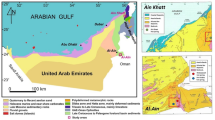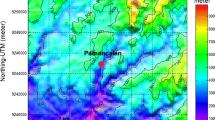Abstract
The geothermal field of Suli and Tulehu is located in the eastern part of the Ambon Island, administratively situated in central Maluku regency, Maluku province, Indonesia. In the year 2017, the measurement of the Earth’s gravity and magnetic field has been done to evaluate the geothermal system in Suli and Tulehu. The application of gravity and magnetic methods was applied to determine the subsurface geological model describing geothermal sources, reservoirs, and faulting as a fluid conduit in the study area. Bouguer anomalies are positive in the range from 93 to 105 mGal, while magnetic anomalies are negative to positive in the range from − 656 to 310 nT, generally southwest to northeast. Geothermal manifestations in the form of hot springs associated with low residual Bouguer and magnetic anomalies positioned on the Banda-Hatuasa, Banda, and Huwe fault lines related to the alteration zone. Euler deconvolution analysis of the complete Bouguer anomaly data shows the maximum depth of fault detected at 1200 m. Gravity and magnetic inversion show high density and susceptibility contrast of rocks associated with Eriwakang and Simalopu pyroclastic rocks as geothermal sources. Low density and susceptibility contrast is estimated to be geothermal reservoirs due to interactions with geothermal source rocks below. A geological conceptual model based on the inversion modeling of gravity and magnetic data provides clear and comprehensive information on the geothermal systems in Suli and Tulehu, Ambon, the eastern part of Indonesia.















Similar content being viewed by others
Data availability
The datasets used during the current study are available from the corresponding author with a reasonable request.
References
Abdel Zaher M, Saibi H, Mansour K, Khalil A, Soliman M (2018) Geothermal exploration using airborne gravity and magnetic data at Siwa Oasis, Western Desert, Egypt. Renew Sustain Energy Rev 82:3824–3832. https://doi.org/10.1016/j.rser.2017.10.088
Araffa SAS, El-bohoty M, Abou Heleika M, Mekkawi M, Ismail E, Khalil A, Abd EL-Razek EM (2017) Implementation of magnetic and gravity methods to delineate the subsurface structural features of the basement complex in Central Sinai area, Egypt. NRIAG J Astron Geophys 7:162–174
Baranov V, Naudy H (1964) Numerical calculation of the formula of reduction to the magnetic pole. Geophysics 29:67–79
Beyhan G, Keskinsezer A (2016) Investigation of the gravity data from Fethiye–Burdur fault zone using the Euler deconvolution technique. Geomech Geophys Geo-Energ Geo-Resour 2:195–201. https://doi.org/10.1007/s40948-016-0028-0
Charlton RT (2010) The Pliocene-recent anticlockwise rotation of the bird’s head, the opening of the Aru trough—Cendrawasih Bay Spenochasm, and the closure of the Banda double arc. In Proceedings of the IPA Thirty-Fourth Annual Convention an Exhibition, Jakarta, Indonesia, 18–20 May 2010
Cooper JRG (2004) Euler deconvolution applied to potential field gradients. Explor Geophys 35(3):165–170
Curewitz D, Karson AJ (1997) Structural settings of hydrothermal outflow: fracture permeability maintained by fault propagation and interaction. J Volcanol Geotherm Res 79:149–168
Fathoni IM (2017) Identifikasi Fitur Sistem Panas Bumi Menggunakan Pemodelan 2.5 D dan Analisis Derivatif pada Data Gravitasi di daerah Prospek Panas Bumi, Tulehu, Maluku. Bachelor Thesis of Geofisika UGM. Yogyakarta
FitzGerald D, Reid A, McInerny P (2004) New discrimination techniques for Euler deconvolution. Comput Geosci 30:461–469
Fregoso BE, García AJ (2015) Structural joint inversion coupled with Euler deconvolution of isolated gravity and magnetic anomalies. Geophysics 80(2):G67–G79
Gomez-Ortiz D, Blanco-Montenegro I, Arnoso J, Martin-Crespo T, Solla M, Montesinos F, Vélez E, Sánchez N (2019) Imaging Thermal Anomalies in Hot Dry Rock Geothermal Systems from Near-Surface Geophysical Modelling. Remote Sens 11(6):675
Gupta H, Roy S (2007) Geothermal energy—an alternative resource for the 21st century. UK: Elsevier. p. 1–271
Hamilton W (1979) Tectonics of the Indonesian region. U.S. Geological Survey, Prof. Pap. 1078, 345 pp
Hochstein MP, Sudarman S (2008) History of geothermal exploration in Indonesia from 1970 to 2000. Geothermics. 37(3):220–266. https://doi.org/10.1016/j.geothermics.2008.01.001
Hohmann GW, Raiche AP (1988) Inversion of controlled-source electromagnetic data. In: Nabighian MN (ed) Electromagnetic methods in applied geophysics, vol 1. Theory. Soc. of Expl. Geophys, Tulsa, pp 469–503
Honthaas C, Maury CR, Priadi B, Bellom H, Cotten J (1999) The Plio – Quaternary Ambon arc , Eastern Indonesia. Tectonophysics 301:261
Jupp DLB, Vozoff K (1975) Stable iterative methods for the inversion of geophysical data. Geophys J R Astron Soc 42(3):957–976. https://doi.org/10.1111/j.1365-246x.1975.tb06461.x
Lewerissa R, Sismanto S, Setiawan A, Pramumijoyo S (2018) The study of geological structures in Suli and Tulehu geothermal regions (Ambon, Indonesia) based on gravity gradient tensor data simulation and analytic signal. Geosciences 8:4
Li Y, Oldenburg DW (1996) 3-D inversion of magnetic data. Geophysics 61:394–408
Linthout K, Helmers H (1994) Pliocene obducted, rotated, and migrated ultramafic rocks and obduction-induced anatectic granite, SW Seram and Ambon, Eastern Indonesia. J Southeast Asian Earth Sci 9:95–109
Lowrie W (2007) Fundamental of geophysics. Cambridge University Press. The Edinburgh Building, Cambridge CB2 8RU, UK
Macleod NI, Ellis GR (2013) Magnetic vector inversion, a simple approach to the challenge of the varying direction of rock magnetization. ASEG-PESA. Australia
Marini L, Susangkyono AE (1999) Fluid geochemistry of Ambon Island (Indonesia). Geothermics 28:184–204
Moghaddam MM, Mirzaei S, Nouraliee J, dan Porkhial S (2016) Integrated magnetic and gravity surveys for geothermal exploration in Central Iran. Arab J Geosci 9(7):1–12
Mortensen KA, Axelsson G (2013) Developing a conceptual model of a geothermal Sistem. Short Course on Conceptual Modeling of Geothermal systems, organized by UNU-GTP and LaGeo, in Santa Tecla, El Salvador
Nasution A, Aviff M, Nugroho S, Yunis Y, Honda M (2015) The preliminary conceptual model of Tolehu geothermal resource, based on geology, water geochemistry, MT, and Drilling. Proceedings World Geothermal Congress. Melbourne, Australia
Nouraliee J, Porkhial S, Mohammadzadeh-Moghaddam M, Mirzaei S, Ebrahimi D, Rahmani MR (2015) Investigation of density contrasts and geologic structures of hot springs in the Markazi Province of Iran using the gravity method. Russ Geol Geophys 56:1791–1800
Peng C, Pan B, Xue L, Liu H (2019) Geophysical survey of geothermal energy potential in the Liaoji Belt, northeastern China. Geotherm Energy 7:14. https://doi.org/10.1186/s40517-019-0130-y
Pirttijarvi M (2012) BLOXER. Interactive visualization and editing software for 3D block models, Version 1.5, User’s guide, Geophysical Survey of Finland
Pirttijarvi M (2014) GRABLOX 2.1. Gravity interpretation and modeling using 3D block models User’s guide to version 2.1. Department of Physics Sciences. The University of Oulu. Finlandia
Reid BA, Thurston BJ (2014) The structural index in gravity and magnetic interpretation; errors, uses, and abuses. Geophysics 79(4):J61–J66
Reid AB, Allsop JM, Granser H, Millett AJ, Somerton IW (1990) Magnetic interpretation in three dimensions using Euler deconvolution. Geophysics 55(1):80–91
Saibi H, Nishijima J, Aboud E, Ehara S (2006) Euler deconvolution of gravity data in geothermal reconnaissance; the Obama geothermal area, Japan. J Explor Geophys Jpn (Butsuri-Tansa) 59(3):275–282
Saibi H, Mogren S, Mukhopadhyay M, Ibrahim E (2018) Subsurface imaging of the Harrat Lunayyir 2007–2009 earthquake swarm zone, western Saudi Arabia, using potential field methods. J Asian Earth Sci 169:79–92. https://doi.org/10.1016/j.jseaes.2018.07.024
Shimada K, Yoshikazu S, Hideo A, Noriaki U, Koichiro F, Mitsuru H, Hiroshi N, Shatei I, Yoshimi F, Kenji S, Kenji F (2011) Final report of “Beta” Geothermal Field, JICA Preparatory Survey for “Beta” Geothermal Field, Unpublished. https://openjicareport.jica.go.jp/pdf/12039947.pdf. Accessed 5 July 2020
Sircar A, Shah M, Sahajpal S, Vaidya D, Dhale S, Chaudhary A (2015) Geothermal exploration in Gujarat: case study from Dholera. Geotherm Energy 3:22. https://doi.org/10.1186/s40517-015-0041-5
Thompson DT (1982) EULDPH: A new technique for making computer‐assisted depth estimates from magnetic data. Geophysics 47(1):31–37
Tjokrosapoetro S, Rusmana E, Suharsono D (1993) Geologi Lembar Ambon, Maluku, skala 1 : 250.000. Pusat Penelitian dan Pengembangan Geologi. Departemen Pertambangan dan Energi. Indonesia
Uwiduhaye JD, Mizunaga H, Saibi HA (2018) Geophysical investigation using gravity data in Kinigi geothermal field, northwest Rwanda. J Afr Earth Sci 139:184–192
Uwiduhaye JD, Mizunaga H, Saibi HA (2019) Case history: 3-D gravity modeling using hexahedral element in Kinigi geothermal field, Rwanda. Arab J Geosci 12:86
Van Bemmelen RW (1949) The geology of Indonesia, Vol. 1A. Government Printing Office, The Hague, 732 pp
Vandani, KPC, Sari AWI, Mulyaningsih E, Utami P, Yunis Y (2014) Studi alterasi hidrotermal bawah permukaan di lapangan panas bumi "BETA", Ambon dengan metode Petrografi. Prosiding seminar nasional kebumian ke-7. Jurusan Teknik Geologi. Fakultas Teknik. UGM. Yogyakarta
Acknowledgments
The authors are grateful to the Ministry of Research and Technology, the Republic of Indonesia, for the opportunity for the first author to take a doctoral program in physics, at Universitas Gadjah Mada, Yogyakarta, in 2014. The authors also thank the government of Maluku province and PT PLN of Maluku and North Maluku regions, which have permitted this research in the Suli and Tulehu geothermal fields. Also thanks to Mr. Markku Pirttijarvi for developing the GRABLOX gravity software for inversion modeling, and Geosoft Inc., which prompted the invitation of authors to use Oasis Montaj software for magnetic inversion modeling for 1 month.
Funding
Data collection refinement and article writing were funded by the Ministry of Research and Technology, the Republic of Indonesia, through a dissertation research grant (1444/E3/LT/2017) with a contract (089/SP2H/LT/DRPM/2017).
Author information
Authors and Affiliations
Contributions
R.L. and S.S. formulated ideas and designs for gravity and magnetic data collection. A.S. reviewed its theory and modeling processing. S.P. evaluated the geology in Indonesia, as well as the geology of Suli and Tulehu in Ambon, while R.L. and L.L. collected a gravity and magnetic data; then, R.L. and S.S. compiled an article that was based on the input from A.S. and S.P.
Corresponding author
Ethics declarations
Competing interests
The authors declare that they have no competing interests.
Additional information
Responsible Editor: François Roure
Rights and permissions
About this article
Cite this article
Lewerissa, R., Sismanto, S., Setiawan, A. et al. Integration of gravity and magnetic inversion for geothermal system evaluation in Suli and Tulehu, Ambon, eastern Indonesia. Arab J Geosci 13, 726 (2020). https://doi.org/10.1007/s12517-020-05735-7
Received:
Accepted:
Published:
DOI: https://doi.org/10.1007/s12517-020-05735-7




